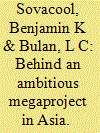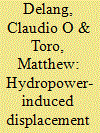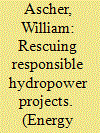|
|
|
Sort Order |
|
|
|
Items / Page
|
|
|
|
|
|
|
| Srl | Item |
| 1 |
ID:
109331


|
|
|
|
|
| Publication |
2011.
|
| Summary/Abstract |
Using a case-study, inductive, narrative approach, this article explores the history, drivers, benefits, and barriers to the Bakun Hydroelectric Project in East Malaysia. Situated on the island of Borneo, Bakun Dam is a 204 m high concrete face, rock filled dam on the Balui River in the Upper Rajang Basin in the rainforests of Sarawak. Bakun Dam and its affiliated infrastructure could be the single largest and most expensive energy project ever undertaken in Southeast Asia. Based on data collected through site visits, original field research in Sarawak, and more than 80 research interviews, the article begins by teasing out the complex history and drivers behind the Bakun project before identifying a set of potential social, political, and economic benefits the project could deliver. It then delves into six sets of barriers in the technical, economic, political, legal and regulatory, social, and environmental realms. We find that Bakun illustrates how centralized energy megaprojects, while ostensibly championed for reasons of economies of scale and the ability to bring about transformational change in the shortest period of time, often fail to address broader development goals such as fighting energy poverty and improving the livelihoods of the local communities they are supposed to serve.
|
|
|
|
|
|
|
|
|
|
|
|
|
|
|
|
| 2 |
ID:
111471


|
|
|
|
|
| Publication |
2011.
|
| Summary/Abstract |
The Lao People's Democratic Republic (PDR) is one of the poorest countries in South East Asia. Yet it has great potential for hydropower development, and the Government of Laos plans to build a large number of hydroelectric dams on the tributaries of the Mekong. Among the areas where these dams are being built is the Bolaven Plateau, the country's main coffee-producing region, inhabited by 22,000 smallholder households (15,000 of which produce coffee), distributed in small villages of 40 to 300 households each. This paper describes the attitudes of the farmers displaced due to the construction of dams. Fieldwork was carried out in communities displaced by two dams: the Huay Ho, completed in 1997, and the Xe Katam, whose construction, at the time of the fieldwork in early 2009, was planned to start in the near future. By comparing these different communities, the authors look at the attitudes, expectations and perceptions of those faced with future relocation, as well as the difficulties and coping strategies of those relocated, 13 years after they were resettled.
|
|
|
|
|
|
|
|
|
|
|
|
|
|
|
|
| 3 |
ID:
177429


|
|
|
|
|
| Summary/Abstract |
Given the still-growing use of coal and natural gas in generating electricity in many developing countries, it is necessary to put far more effort into promoting responsible large-scale hydropower projects. In contrast to hydro, solar and wind power face physical constraints that greatly limit their potential to replace fossil-fuel sources of power generation. Because designing hydro projects to reduce their socio-economic and environmental damage typically entails greater costs and/or lower capacity, subsidies are needed to increase the number of responsible, economically viable projects. Despite the past abuses, hydro offers low-carbon energy generation, low-cost power generation, and important potential for energy storage and peaking supply to supplement intermittent low-carbon sources such as wind and solar. The promotion of responsible hydropower requires greater awareness of the possibilities for responsible projects, greater overall climate funding, better provision for local participation and compensation, changes in the doctrines of additionality, and stronger institutions to identify, design, and broker these projects.
|
|
|
|
|
|
|
|
|
|
|
|
|
|
|
|
|
|
|
|
|